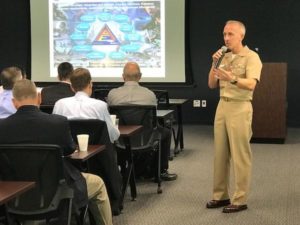
Capt. Chris ‘Mini’ McDowell said open architecture approaches and standards enable breaking vendor locks, increased competition and greater interoperability across the fleet during PMA-209 Industry Day, Sept. 18, 2018. During the PMA-209 event speakers ask industry to suggest solutions, while challenging processes and procedures that hinder speedy delivery of capabilities.
“Allow your folks to fail, learn, then recover,” said Daniel Nega, the deputy assistant secretary of the Navy for air programs during an industry brief at PMA-209’s Industry Day, September 18-19, 2018. “Don’t just hire more people. Solve within your means.”
His challenge to government and industry is to encourage a shift in perspective toward new business practices that incorporate speed, agility, open architectures and affordability, as mandated by the Assistant Secretary of the Navy for Research, Development and Acquisition, the Honorable James ‘Hondo’ Geurts.
“We don’t need too many specialists; we need generalists too,” he said.
At Naval Air Systems Command (NAVAIR), PMA-209 provides management for the acquisition of air combat electronics and systems, yet, the program falls under the larger AIR 1.0, which spans aviation acquisition for business operations, services and equipment NAVAIR-wide.
“Help me, help you, help us,” said Gary Kurtz, the assistant commander for Acquisition (AIR-1.0). “Demand from us clarity on our requirements. Demand us be as detailed as we can be in this forum.”
It’s about partnership. You need to help us in terms of the delivery of your capability, Kurtz said after outlining the top challenges.
PMA-209 met with Industry for the two days, but within the same week another AIR 1.0 Industry Day, hosted by PMA 202 discussed Physiological Monitoring, which foot stomps NAVAIR’s commitment to partnering with industry to ensure collaboration on the issues that matter most to the Fleet. At both events, officials discussed leveraging government and industry tools to meet the Navy’s most urgent requirements. The dialogue is about streamlining contracting and proposal processes to ensure the quick delivery and deployment of cutting edge technologies.
“We have to try to be quicker and more agile, and what we buy needs to be less expensive,” Nega said. “Changing behavior is hard.”
Kurtz said he is committed to facilitating processes that reduce time and save money.
“I no longer want to see it take a year and a half to award contracts,” he said. “I want a 180-day plan.”
“The fleet is about 20 years old. There are aging aircraft with sustainment challenges. We’ve got to sustain the aging aircraft faster and one way is with new technology,” he said.
At close to full capacity, industry asked questions about process and submitting ideas.
“SBIR [Small Business Innovation Research] is a powerful tool, if you want speed to the Fleet,” said Tom Lansing, senior business development director of Navy programs at Physical Optics Corporation. “They are pre-competed by technologies of interest to the PMAs, and there are off ramps if the technology isn’t working you don’t have to take it.”
“If it is working, you have an immediate way to go sole-source,” he said.


